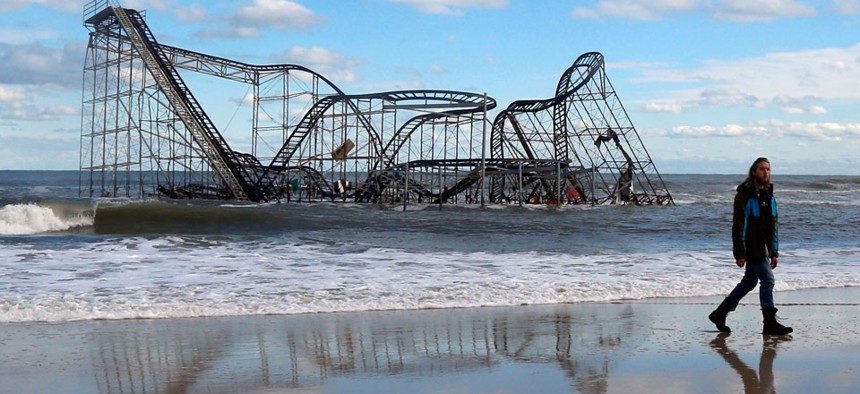How Lasers Will Give the U.S. East Coast Precise New Post-Sandy Maps

A rollercoaster that once sat on the Funtown Pier in Seaside Heights, N.J., now rests in the ocean. Julio Cortez/AP
The survey will kickoff the most revolutionary American mapping project in a century.
Ten months after Superstorm Sandy made landfall on the U.S. East Coast, causing over $65 billion in damage and bringing New York and New Jersey to a standstill, one consequence of the storm is just now coming into focus: its impact on the shape of the coastline, underwater and above.
The storm's devastating effect on human settlements—flooded subways, submerged houses, and hundreds of fatalities—has been well documented. But as the National Oceanic and Atmospheric Administration, the U.S. Geological Survey, and the U.S. Army Corps of Engineers begin a post-Sandy survey from Myrtle Beach to Montauk, its geological footprint remains largely unknown.
Revealing it, with the help of the laser surveying technology lidar, will be the first step of a program that will ultimately overhaul American cartography. By 2023, the USGS aims to have have the entire contiguous United States mapped with a margin of error of just a few centimeters.
It begins with the coastline of the Mid-Atlantic, as fickle a landscape as there is. The sandy shorelines that make the beaches of New Jersey and Long Island so popular with sunbathers ensures that their shape is, from a geological perspective, remarkably dynamic. Before human settlement shored up the form of Fire Island, for example, the 26-mile barrier off the coast of Long Island moved west at a rate of 150 feet per year.
The physics of sand is not rocket science; it may be even harder. Albert Einstein supposedly warned his son against pursuing it professionally. Accordingly, Jeff Ferguson, chief of the NOAA Hydrographics Survey Division, was reluctant to speculate about what the new maps will show. Underwater sand deposits may have accumulated, or receded. Changes may be limited to shallow depths, or not.





